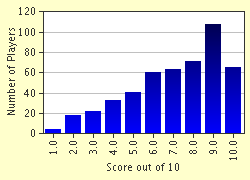Quiz Answer Key and Fun Facts
1. "The Yellow Kid" began his humble career in Hogan's Alley in 1895. In time the kid's words were in speech balloons; his antics were portrayed in separated panels; and his creator, Richard Outcault, was considered by many to be responsible for creating the first modern American comic strip. With what else has Outcault been credited?
2. In 1897, a new American comic strip appeared and featured two mischievous boys whose characters were suspiciously similar to those appearing in German periodicals in the 1860s, as Max and Moritz. While some consider this to be the first "true" modern comic strip, there is no doubt that it is the longest running as of 2005 since it remains in syndication as of that date. What is the name of this comic strip?
3. Of course, comic strips need not and did not restrict their narratives to comedy. A spin-off character from a strip entitled "Wash Tubbs" is held to be America's first, full-fledged adventure comic strip hero. What was the name of this character? (Hint: you most likely have not heard the name before.)
4. Cartoon character Professor Lucifer Gorgonzola Butts invented terribly complicated machines to perform the simplest of tasks. A 1995 U.S. postage stamp commemorates the comic strip author who created the good professor. Which author does the stamp celebrate? (Hint: these devices are invariably named after the author rather than the professor.)
5. American comic strips have both influenced and been influenced by history. In 1937, a character was created who would ultimately be involved in a number of historical events. This intrepid knight from the Norwegian kingdom of Thule witnessed the sack of Rome, was accused of the murder of the Roman general that defeated Attila the Hun and visited Camelot. A 1995 U.S. commemorative stamp bears his visage and the newest set of his adventures that began in 2004 are expected to last 1800 Sundays. Which of the following is the comic strip that bears our hero's name?
6. Who is both the earliest and longest running cavemen in newspaper comics' history and has the distinction of having landed on the moon?
7. In the 1950s, in his comic strip, Walt Kelly portrayed the then powerful Senator Joseph McCarthy as an unreasonable and malignant bobcat named Simple J. Malarkey and depicted McCarthy's protégé Richard Nixon as a sleazy goat. What was the name of the strip illustrated by this courageous cartoonist?
8. Bill Watterson's "Calvin and Hobbes" debuted in 1987. The strip became extraordinarily popular. In 1992, following a sabbatical, Watterson made a demand for which he was roundly criticized by cartoonist Bill Keane and multiple newspaper editors. What was his "outrageous" demand?
9. In 1968 a Yale student produced "Bull Tales" for the Yale student newspaper. Taking a new name, the strip moved to commercial newspapers in 1970. This controversial comic strip is often found in the editorial pages rather than the comic pages. What is the name of this Pulitzer Prize winning comic strip?
10. Topics that are freely and openly presented in other areas of the newspaper may be controversial in the comic pages. Newspapers have refused to publish comic strips involving which of the following?
Source: Author
uglybird
This quiz was reviewed by FunTrivia editor
linkan before going online.
Any errors found in FunTrivia content are routinely corrected through our feedback system.

